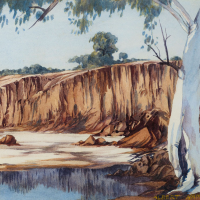ALBERT NAMATJIRA

My grandfather, Albert Namatjira, his country starts from Ormiston Gorge, the Finke River and goes right down to Palm Valley. To the east of the gorges is the MacDonnell Ranges. My grandfathers dreaming is there and its very important country.1
Albert Namatjiras granddaughter, Jillian Namatjira
Over time, the precise names of the locations depicted in many of Namatjiras paintings have been lost. However, the steep riverbank in the background of the present work, together with the still pool of water in the foreground, indicate that this work portrays the Finke River. Other watercolours such as Ghost Gum and Finke River Bank c1956 (illustrated on page 382 of the recently published The Life and Times of Albert Namatjira by Ken McGregor),2 employ the same pictorial elements and a similar composition. When considering Namatjiras depictions of the Finkes parched riverbed, it is helpful to read author and anthropologist Charles Percy Mountfords description:
In early geological times, the Finke was a deep, quick-flowing stream that emptied its waters into Lake Eyre. With the gradual drying up of Central Australia, this, and other large water-courses of the Centre, became dead rivers that only flow for a short time after the heavy rains. During those early times the Finke River carved some remarkably beautiful gorges through both the MacDonnell and the James Ranges.3
The remarkable beauty of these gorges impressed Namatjira, who often returned to the subject throughout his career. The present work demonstrates how the natural elements of the landscape provided ideal compositional devices for the artist. First the eye wanders across the stagnant, reflective water that bleeds across the lower edge of the composition. This smooth horizontal plane then continues across the sandy river bottom, before being abruptly halted by the vertical wall of earth, with its shadowy and streaky rivulets. Namatjira then employs his iconic white gum tree as a framing device, cutting through each layer of landscape, lifting our eye into the sky, and creating an organic upper edge to the composition using its dangling leaves.
Interestingly, Namatjira has signed this work using a yellow pigment, rather than his usual black. While rare, there are several examples of him signing in yellow dating from the early 1950s. Most notable of these examples is Evening Light, Gosses Range, West MacDonnell Ranges, Central Australia c1950 which is held in the collection of the National Gallery of Australia and is illustrated here as Figure 1.
Central Australian Landscape (Finke River) was given by the artist to Frank Wolfe who was working in Alice Springs as a supervisor of a local housing commission during the late 1950s. Since then, it has remained in the same family, this being its first ever public appearance. In a letter handwritten by Frank Wolfes wife, it is stated that Namatjira gave the piece to Frank at Morris Soak (Akngwertnarre), a camp on the north-west outskirts of Alice Springs where Albert Namatjira lived during the 1950s.4 Not long afterwards, Namatjira sadly passed, to be remembered as one Australias most inimitable and well-loved artists.
Footnotes:
1. Jillian Namatjira, as quoted in French, A., Seeing the Centre: The Art of Albert Namatjira 1902 1959, National Gallery of Australia, Canberra, 2002, p.29
2. McGregor, K., The Life and Times of Albert Namatjira, Badger Editions, Melbourne, 2021, p.328
3. Mountford, C. P., The Art of Albert Namatjira, Bread and Cheese Club, Melbourne, 1944, p.63
4. Kleinert, S., Albert Namatjira, Australian Dictionary of Biography, Australian National University, Canberra, viewed 21 February 2022, https://adb.anu.edu.au/biography/namatjira-albert-elea-11217
Asta Cameron